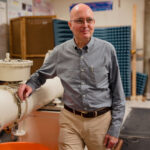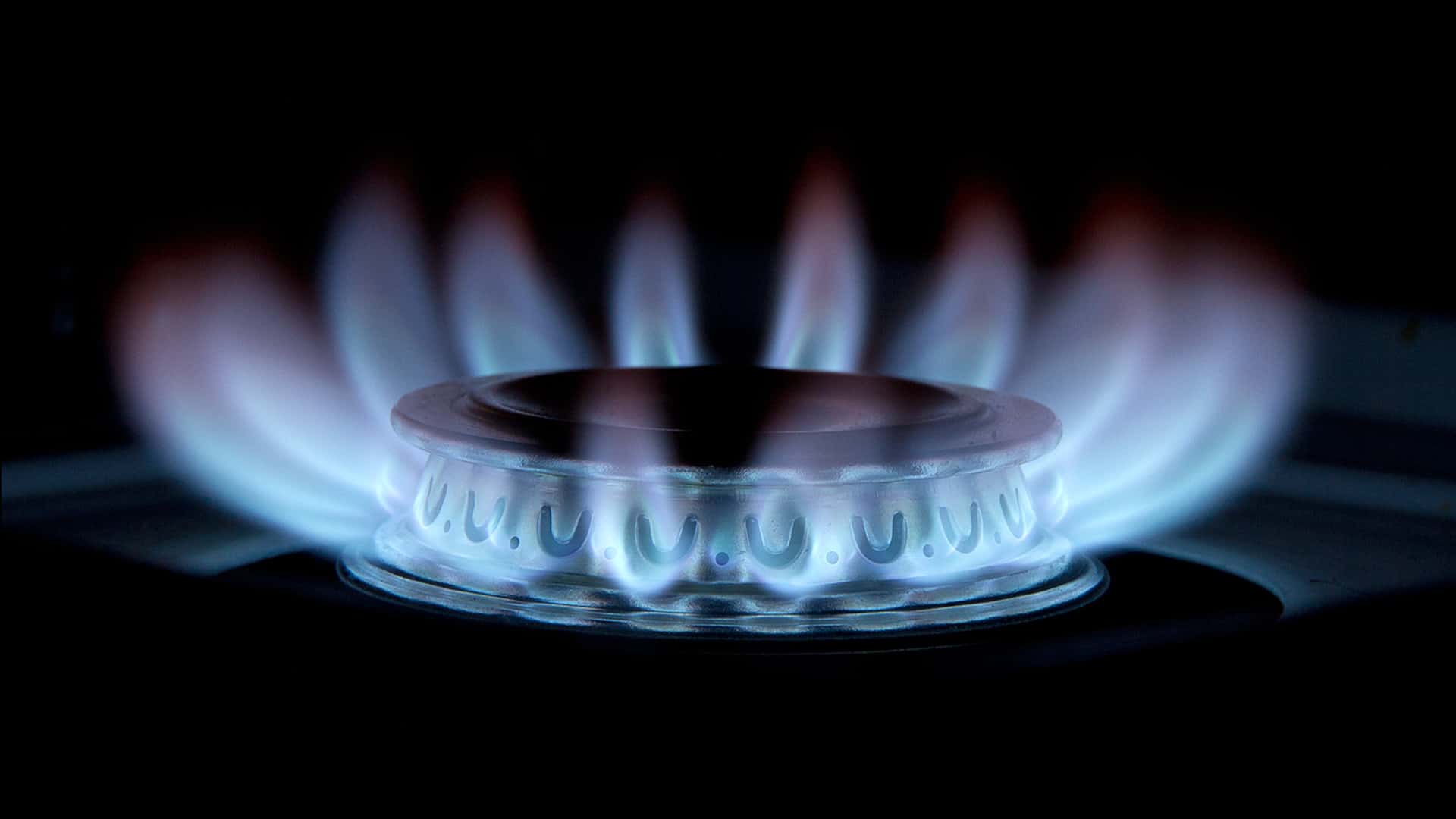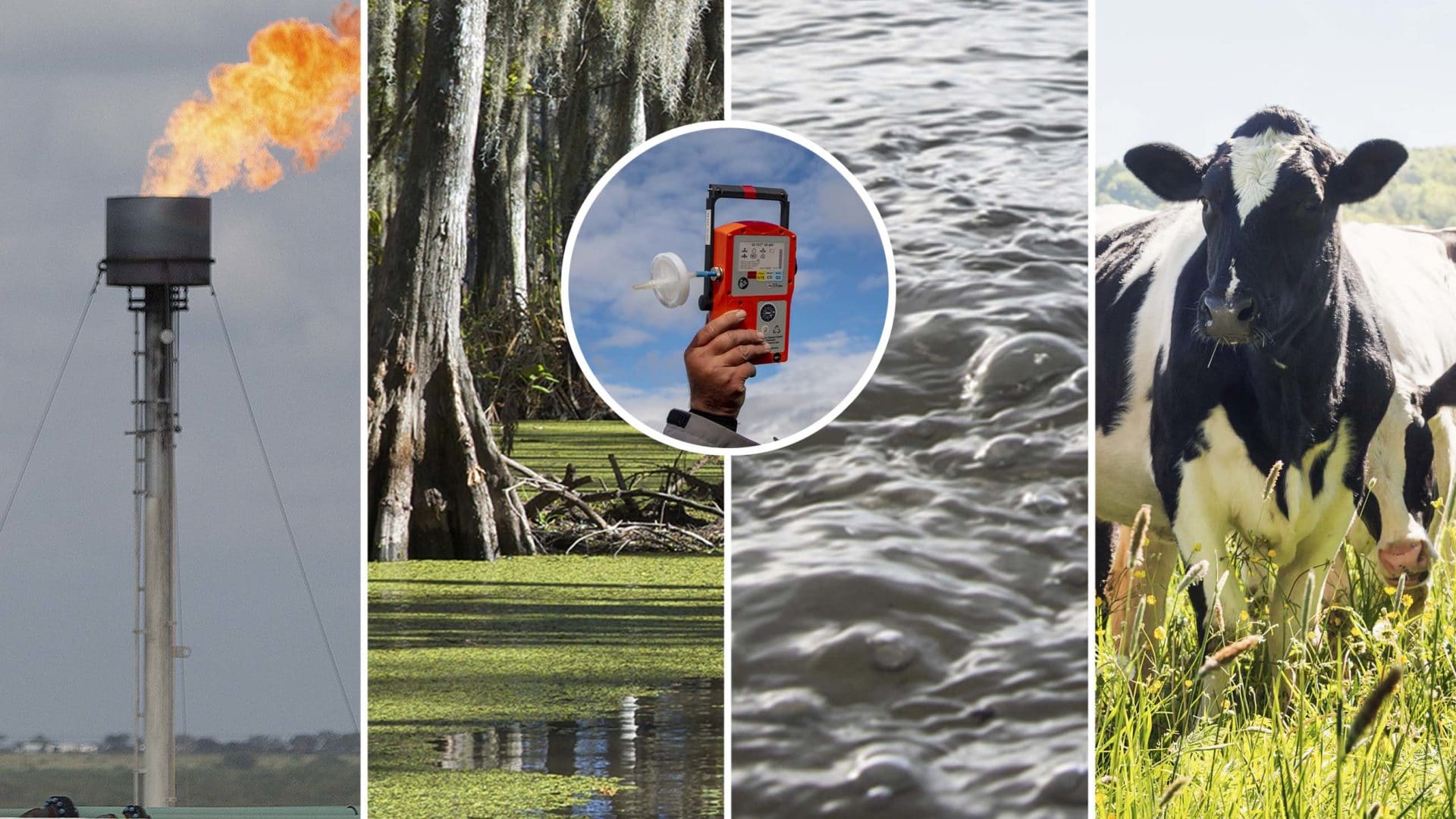Amid Covid, the Air Hazards of Gas Appliances Draw New Scrutiny
As a physician and epidemiologist with the U.S. Centers for Disease Control and Prevention, T. Stephen Jones spent his career fighting major threats to public health in the United States and globally, from smallpox to HIV to viral hepatitis. But it wasn’t until Jones was well into retirement that he learned about a widespread yet widely overlooked health risk in his own home in Florence, Massachusetts, and in most U.S. households: pollution emitted by natural gas appliances.
While many Americans might think illness linked to indoor cooking and heating is a problem confined to smoke-filled kitchens in the developing world, the natural gas-burning stoves and furnaces found in millions of U.S. kitchens and basements can produce a range of health-damaging pollutants, including particulate matter (PM), nitrogen dioxide (NO2), carbon monoxide (CO), and formaldehyde. Over the past four decades, researchers have amassed a large body of scientific evidence linking the use of gas appliances, especially for cooking, with a higher risk of a range of respiratory problems and illnesses.
Since the publication of two new reports on the subject from the nonprofit research group the Rocky Mountain Institute (RMI) and the UCLA Fielding School of Public Health, this past spring, the existence of these gas-fired health hazards has garnered increasing media scrutiny. But less discussed has been how the Covid-19 pandemic has compounded the risks of this pollution, especially for low-income and vulnerable populations, and how key regulatory agencies have lagged decades behind the science in acting to protect them.
“There’s no question this has been a neglected issue,” said Jones, who has drawn on lessons from his long career in public health epidemiology and disease prevention in sounding the alarm throughout Massachusetts and with former CDC colleagues over the past few years. The first step, he said, is “letting people know what the risks are — particularly when they can be substantial, life-threatening risks that can kill kids.”
One of the clearest signals emerging in the scientific literature is the connection between cooking with gas and childhood asthma — a disease suffered by people of color and lower-income groups at much higher rates than the rest of the population. A 2013 meta-analysis of 41 studies found that children living in homes with gas stoves had a 42 percent higher risk of experiencing asthma symptoms, and, over their lifetime, a 24 percent increase in the risk of being diagnosed with asthma. That study confirmed, in turn, what a 1992 meta-analysis found: Children exposed to higher levels of indoor NO2 (at an increment “comparable to the increase resulting from exposure to a gas stove”) had an elevated risk of respiratory illness. More recently, a 2018 study from the University of Queensland found that in Australia, where 38 percent of households rely on gas stoves for cooking, more than 12 percent of the total burden of childhood asthma was attributable to their use.
Meanwhile, troubling new findings suggest that exposure to NO2 — the primary pollutant of concern from gas appliances — could compound the dangers of the novel coronavirus in communities that are already at higher risk of infection and of dying from the disease. A recent peer-reviewed study led by researchers at Emory University examined Covid-19 mortality data in more than 3,000 U.S. counties, and found that long-term exposure to elevated NO2 was correlated with a higher risk of death from Covid-19 — and that NO2 appeared to be more dangerous than particulate matter or ozone.
The hazards now have a growing chorus of scientists and public health experts insisting that better and stricter oversight of burning gas indoors — a health threat that has been hiding in plain sight for decades, they say — can no longer be ignored. “It’s fundamental and imperative,” said Jones. “We ought to get up on the rooftops and shout about it.”
The cumulative evidence was enough for the venerable New England Journal of Medicine to publish an editorial in January recommending that “new gas appliances be removed from the market.” It was co-authored by Howard Frumkin, a former director of the CDC’s National Center for Environmental Health, which is responsible for investigating environmental drivers of illness and promulgating guidance about those risk factors.
Despite such calls — and despite compelling evidence that gas appliances can produce levels of air pollution inside homes that would be illegal outdoors in the United States — indoor air quality remains entirely unregulated in the U.S. today, and gas appliances largely maintain their industry-manufactured reputation as “clean.” The Environmental Protection Agency only monitors pollutants in outdoor air. And while building codes typically require natural gas furnaces and water heaters to be vented outside, many states lack requirements that natural gas cooking stoves be vented to the outdoors.
Still, recent signs suggest that some measure of regulatory action reflecting the current understanding of the health risks of gas cooking and heating devices might finally be forthcoming. At the end of September, the California Energy Commission held a day-long workshop on indoor air quality and cooking to inform its triennial update to its building energy efficiency standards. The California Air Resources Board (CARB), which regulates air pollution in the state, presented evidence that gas stoves harm health, and that a statewide transition to electric appliances would result in substantial health benefits. These obscure energy code deliberations have generated an unprecedented number of public comments — testament, advocates say, to mounting concern about greenhouse gas emissions, and to growing awareness of the health impacts of residential fossil fuel use.
Last month, the 16 members of CARB unanimously adopted a resolution in support of updating building codes to improve ventilation standards and move toward electrification of appliances — making California the first state to issue official guidance addressing the health impacts of gas stoves and other appliances.
This guidance — which cited the evidence linking gas appliances with asthma and exposure to air pollution more generally with elevated Covid-19 risks — boosts the hopes of those advocating for the decarbonization of California’s buildings that the Energy Commission will require new construction in the state to be all-electric in 2022. If that happens, it would instantly transform the country’s largest market for gas appliances, in a move that could reverberate nationwide.
Until then, advocates for reform suggest they’ll keep pushing — not least because, while this long chain of evidence would be worrying under any circumstance, the Covid-19 pandemic is keeping more people inside cooking at home than ever before.
Jones’ advocacy started with a phone call. In 2017, his wife, Adele Franks, also a retired public health physician, received a call from the local chapter of the Sierra Club, asking if she would like to help raise awareness among Massachusetts state public health officials about the health effects of gas appliances. She was too busy, so Jones took on the project instead.
He started digging into the peer-reviewed literature. He called experts on air pollution and respiratory health at research universities and reached out to former colleagues at the CDC. While the topic was new to him, analyzing epidemiological studies and assessing their rigor was not. At the CDC, Jones had worked on childhood immunization and child survival programs in Latin America and Africa and spent over a decade as its lead policy expert on HIV and viral hepatitis prevention. (He and Franks are both alumni of the CDC’s Epidemic Intelligence Service, which trains “disease detectives” to investigate and respond to public health emergencies in the U.S. and around the world.)
Jones says he was struck by the discrepancy between the firmness of the evidence and the nearly non-existent response from regulators and public health agencies. Indeed, he found the evidence so persuasive that he traveled around Massachusetts, making presentations to local boards of health in more than 70 different cities and towns.
“One of the things I would always ask them was, ‘Have you heard about this connection between cooking with a gas stove and increased asthma among children living in the household?’” Jones said. The answer he received — from health board members and from former colleagues working in medicine and public health — was almost always “No.”
At around this same time, Brady Seals, a researcher at the Rocky Mountain Institute (RMI), a nonprofit clean energy think tank, who co-authored its recent report summarizing decades’ worth of research on the health effects of gas stoves, was combing through the preceding 20 years’ worth of peer-reviewed studies on the subject. She pored over the EPA’s 2008 and 2016 Integrated Science Assessments on nitrogen oxides, the latter of which concluded that short-term NO2 exposure can exacerbate asthma and cause other adverse respiratory effects.
“The more I dug in and talked to experts in the field, I kept waiting to find out we were wrong,” Seals said. “It was the opposite. In every case, the evidence seems to be strengthening on NO2 and its impacts on health.” The RMI report (co-sponsored by advocacy groups Mothers Out Front, Physicians for Social Responsibility, and the Sierra Club) drew on that evidence to conclude that combustion products emitted by natural gas stoves can cause chronic respiratory illness.
“And the fact that these gas stoves contribute to elevated NO2 is indisputable,” added Seals.
Indeed, the EPA’s own analysis has found that American homes with gas stoves have much higher concentrations of NO2 than those using electric stoves — levels that would violate legal limits if measured outdoors.
Several of the studies cited in RMI’s report were led by Brett Singer, a staff scientist and leader of the Indoor Environment Group at Lawrence Berkeley National Laboratory (LBNL), who has been studying indoor air pollution for two decades. Measurement studies have found higher concentrations of NO2 and other pollutants in homes that rely on gas cooking since at least the 1980s, he said in an email.
“It is still a big problem,” he said. “LBNL has done several moderately-sized measurement studies in California in the past 10 years to show that elevated pollutant concentrations are still associated with gas cooking.”
Given that more than a third of all U.S. households rely primarily on gas for cooking, the extent of the damage to people’s health, the RMI report concluded, could be quite large.
Seals spent over a decade working on clean cookstove programs in the developing world, where pollution from reliance on burning wood, coal, and dung for cooking kills 3.8 million people each year. But like Steve Jones, she wasn’t aware of these health risks from a fuel long touted by the natural gas industry, and embraced by the American public, as clean. “I was working on nothing but cookstoves for the past 11 years, but I didn’t really know a lot of this,” she said. “It’s humbling, in a way.”
The links between gas appliances and asthma — and the fact that environmental regulators and consumer protection agencies have long ignored the risk — have both been on Kevin Hamilton’s radar for a while. Hamilton is a licensed respiratory therapist and leader of the Central California Asthma Collaborative (CCAC), an organization that provides direct support to residents of California’s San Joaquin Valley who suffer from asthma and advocates for policy on their behalf.
In the San Joaquin Valley, which has long had some of the worst outdoor air pollution in the U.S., as many as 1 in 4 children have asthma. But from his years of working directly with asthmatics, Hamilton knows firsthand that their indoor air can trigger asthma, too.
His organization’s community health workers regularly visit homes to look for potential asthma triggers like mold, dust, and allergens, and help homeowners find ways to reduce their exposure. (Since the Covid-19 pandemic emerged, CCAC staff have been doing “virtual” home assessments using smart phones.) One of the key items on their checklist: the presence of a gas appliance. “We note whether or not they have a gas stove or electric stove, and gas for their heating and cooling,” Hamilton said. “Some homes are pretty old, and still have wall furnaces and floor heaters. We have concerns about all those things.”
Californians’ gas consumption is much higher than the national average. In about two thirds of California’s 14 million homes, gas is the primary cooking fuel, and a similar share relies on gas for heating. (Nationwide, 58 percent of households rely on natural gas as their main space heating fuel and 56 percent use gas for water heating, according to the Energy Information Administration.)
The vast majority of households that the asthma collaborative serves are low-income. “Our families are all on Medicaid or underinsured,” Hamilton said. Unvented gas-burning space heaters are illegal in California, but he noted that plenty of people still use them because they can’t afford alternatives or live in sub-standard rental housing.
These gas heaters can be even more dangerous than gas cooking appliances, Singer noted, because they are used for much longer periods, and are designed to vent directly into the living space, resulting in “very high pollutant concentrations.”
And some people, especially renters, even use their gas ovens as supplemental heating sources in the winter, or as a primary one if their electricity gets shut off.
“These are the most vulnerable folks, and have the least resources to do anything about this,” Hamilton said. “Especially in a home with poor ventilation, these particles can be highly concentrated with long-term health effects on people’s lives.”
Yifang Zhu, a professor of environmental health sciences at UCLA’s Fielding School of Public Health, underscored that point. “Smaller spaces, with more people in them, and poor ventilation, especially in rental apartment units, all mean higher levels of pollutants,” she said.
Zhu led a team of researchers that published a report in April examining the impact of natural gas appliances — including furnaces and water heaters — on health and air quality in California. One of the most striking findings from their modeling: In nearly all small apartments, cooking for just one hour on a gas stove results in NO2 concentrations that would far exceed ambient air quality limits set by the EPA and CARB.
Many of the houses and apartments that the asthma collaborative’s health workers evaluate don’t have functioning range hoods. And survey data cited by Zhu shows that only about a third of Californians who do have exhaust hoods use them regularly.
“Our work highlights that environmental-justice communities are disproportionately impacted by these issues,” Zhu said, referring to low-income and minority communities who often have higher exposures and greater vulnerability to environmental harms. “We need to understand there’s a cumulative, compounding health impact of those environmental conditions those populations are experiencing.”
Zhu’s team also calculated how much outdoor concentrations of nitrogen oxides and PM2.5 — microscopic, airborne particles 2.5 micrometers or less in diameter — would be reduced by eliminating natural gas appliances from California homes. They estimated that the health benefits of going all-electric — in the form of avoided deaths and chronic illness — would amount to $3.5 billion per year.
And that estimate does not include the added benefits of indoor air quality improvements. Gaining access to people’s homes to observe their cooking and heating preferences and patterns, understand the physical layout, and monitor personal exposure is both logistically and ethically challenging, given privacy concerns and funding constraints. As a result, there are comparatively fewer studies that involve direct measurements of indoor air and individuals’ exposure.
Still, Zhu noted that if the impacts of breathing indoor particulate matter, carbon monoxide, and nitrogen oxides from gas combustion were tallied up, the health benefits of avoiding that exposure would almost certainly be far larger. “We know the most serious impacts happen indoors, so we can assume most health benefits will occur from replacing those indoor polluting appliances,” she said.
The toll exacted by asthma alone gives a sense of the potential scale. Nearly 1.5 million children in California suffer from asthma. A 2015 report by the California Environmental Health Tracking Program found that childhood asthma results in more than 72,000 emergency room visits and 1.3 million missed school days per year. It calculated that the costs of childhood asthma — both the direct costs of treatment and hospitalization, as well as indirect costs from keeping sick kids home from school — due to environmental factors alone would be $208 million. The total cost of all asthma in the state, among children and adults, is estimated to be $11 billion.
During the recent wildfires plaguing California, CARB tweeted advice to stay indoors and shut windows to avoid breathing wildfire smoke. “Avoid vacuuming, frying foods or using gas-powered appliances,” the agency added.
For the millions of Californians who cook and heat with gas, however, that guidance presents an impossible choice — as does the specter of Covid-19, which has more of us worried about indoor ventilation. Several new studies suggest that people infected with SARS-CoV-2, the virus that causes Covid-19, who have higher exposure to air pollution are more likely to have severe cases of the disease.
“The people most burdened by these impacts are those who struggle the most to pay for cleaner alternatives,” says Seals. “We need policymakers to target those folks, and we need better rebates for electric stoves.”
For a long time, the blue flame coming out of a gas burner has evoked cleanliness. That was no accident, but the result of a concerted advertising campaign.
In the late 19th century, the nascent natural gas industry began marketing their product to homeowners as a cleaner, more hygienic alternative to coal and wood. After the famous comedian Bob Hope popularized the catchphrase “now you’re cooking with gas!” on his 1930s-era radio show, the slogan became synonymous with “modern, efficient, clean.”
Compared to the wood and coal it replaced in U.S. households, gas was, and is, undoubtedly far better for air quality and health. That’s still true for the billions of people in the developing world who rely on solid fuels for cooking and heating, and are exposed to dangerous smoke every day as a result.
But the catchphrase is in need of updating, critics of such marketing argue. Compared to electric-powered appliances, gas burners are unquestionably more polluting. Induction cooktops — which use magnetic fields to heat pots quickly, rather than burning gas or using the resistance heating coils of conventional electric ranges — have been widely used in Europe for many years, and are now becoming more available in the U.S.
“Induction is both cleaner with fewer pollutant emissions and also the most efficient and least dangerous in terms of burns and fires,” said Brett Singer, “but cooking on induction still can produce pollutants that need to be vented.” Using a ventilation hood is essential with any cooking system, he emphasized.
Electric-powered induction cooktops may save energy and help homeowners breathe easier, but they are more expensive than conventional gas stoves. Right now, the only incentive program in California is a rebate of $100 to $750 from Sacramento’s municipal utility for homeowners who switch to an induction cooktop.
“We’re not accounting for what the pollution from gas stoves is doing to health costs, so we can’t monetize those,” Seals argued. If policymakers took those health costs into account, she added, the dollar value of all those avoided emergency room visits for asthma attacks and lost school and workdays could make wide-scale programs incentivizing adoption of induction cookers look like a bargain.
California is the birthplace of a growing movement by towns and cities to ban natural gas use in new construction. Nearly 40 cities and towns throughout the state have adopted ordinances mandating all-electric appliances in new residential buildings, with San Francisco among the most recent to do so. But those ordinances don’t touch the 70 million existing buildings in the U.S., including California’s 14 million homes — 90 percent of which use natural gas in some form. Retrofitting those homes with electric heat pumps and water heaters and induction cooktops would be an expensive, politically-fraught undertaking.
Organizations such as the Sierra Club and the Natural Resources Defense Council are pushing for state and regional air quality management districts to put in place tighter limits on outdoor emissions from gas appliances. If that happens, it could drive up the costs of those appliances. As homeowners and landlords increasingly switch to electric alternatives for space heating and heating water, keeping the gas line to a building just to supply a stove will become too expensive to justify.
But without targeted incentives, most homeowners and renters won’t be able to afford new heat pumps and induction cookers, and will be stuck paying for increasingly costly gas hookups.
“People are generally not aware of this issue,” said Hamilton. “Even our asthma patients who we educate about this, they just nod. They’d take a free electric range in a minute. But there’s no incentive to do that. There’s no source of funding — that’s key.” The frustration was evident in his voice when he said, “this is just not a regulated area.”
In Massachusetts, Steve Jones’ efforts helped persuade more than 100 boards of health (representing more than half of the state’s population, and including those from the three biggest cities of Boston, Worcester, and Springfield) to write to Gov. Charlie Baker to express concerns about the health impacts of natural gas consumption and infrastructure, and helped secure the adoption of an unprecedented resolution from the Massachusetts Medical Society, the nation’s oldest, recognizing that gas stoves contribute to childhood asthma.
But while these gestures might boost awareness, they haven’t precipitated any changes to the state’s building codes or official state health guidance, nor have they unlocked any resources to help lower-income households make the transition from gas to electric cooking.
Before the pandemic shut everything down, Jones would drive down I-91 to Springfield from his home near Northampton to meet with officials running the city’s Healthy Homes Program, which aims to help reduce environmental triggers of asthma in the home and provides zero-interest loans to upgrade housing for lower-income households.
The Asthma and Allergy Foundation of America ranks Springfield as the most challenging city in the country to live with asthma. Jones wanted to put them in touch with counterparts in Worcester, who were using Department of Housing and Urban Development funding to rehabilitate rental housing, including installing wiring to enable a switch to electric cooking.
Now those conversations are on hold, but the risks haven’t gone away, said Jones.
“Covid-19 has dramatically demonstrated the health threats of living in small, crowded housing, typically apartments,” he said. “The interior air pollution from gas cooking stoves may contribute to the higher rates of Covid-19 in Chelsea, Lynn, Worcester, and Springfield.”
Nearly a quarter-century ago, a commentary appeared in The Lancet, the highly respected British medical journal. “The relation between respiratory health and indoor pollution from [gas] appliances has received considerable attention during the past 25 years; both positive and negative associations have been reported,” the authors noted. “Nevertheless, as the researchers suggest, continued investigation of the role of gas appliances and NO2 in the development and aggravation of respiratory disease is clearly warranted.”
The authors were commenting on a study published in the same issue of The Lancet that tracked 15,000 adults in East Anglia, U.K., and found that women who cooked primarily with gas stoves had a significantly higher risk of asthma-like symptoms and reduced lung functions in tests than those who didn’t. (Intriguingly, they found no significant association among men, perhaps explained by the fact that women spent more time in the kitchen cooking, and in the home generally.) They concluded: “Although the issue of indoor gas appliances, NO2, and respiratory health is not new, this remains an extremely common, possibly increasing, exposure throughout the world. The stakes are high.”
Despite those high stakes, the issue has received scant attention from policymakers and public health authorities up to this day. The natural gas industry points to this fact as an indication that there is nothing for homeowners to worry about, and that its product is safe to burn in the home.
Audrey Casey, a spokesperson for the American Public Gas Association (APGA), a national trade group for municipally-owned gas utilities, flatly denied any link between gas cooking and asthma, despite the emerging consensus from the scientific community. “The risks to respiratory health from NO2 documented in the scientific literature are not associated with gas stoves,” Casey said in an email message. “The association between the presence of a natural gas cooking appliance along with the increases in asthma in children is not supported by data-driven investigations that control for other factors that can contribute to asthma and other respiratory issues.”
 |
For all of Undark’s coverage of the global Covid-19 pandemic, please visit our extensive coronavirus archive. |
She also noted that the Consumer Product Safety Commission (CPSC), which oversees safety and performance standards for consumer appliances like water heaters, furnaces, and stoves, and the EPA “do not view gas ranges as a significant contributor to adverse air quality or a health hazard in their technical or public information literature, guidance, or requirements.”
While the EPA does not regulate indoor air quality, it does provide extensive information through its Indoor Air Quality program, based on its decades of analysis of the same pollutants found in outdoor air. The EPA includes NO2 on its list of asthma triggers; “unvented combustion appliances, e.g. gas stoves” is first on its list of primary sources of NO2 indoors.
“Existing regulations — including from the CPSC — have found no health or safety risk associated with normal use of gas appliances,” the APGA’s Casey added.
Writ large, the industry’s core response to the scientific indictments laid out in the Rocky Mountain Institute and UCLA reports might be summarized this way: If gas appliances are so dangerous, why aren’t they regulated more tightly?
But critics of the industry ask precisely the same question: Given the evidence, which has mounted for decades, why hasn’t the CPSC or the CDC taken any action to limit indoor pollution from gas appliances, or issue updated guidance to health professionals and homeowners?
One possible reason, experts say, is that it’s not clear which U.S. federal agency is responsible for regulating indoor air. The EPA has the authority, under the Clean Air Act, to regulate outdoor air. Should setting standards for the air we breathe indoors be under the purview of a health-focused institution like the CDC? Or should the CPSC take the lead?
In 1985, the chair of the CPSC wrote to the EPA, requesting help in determining whether gas stoves and appliances produced dangerous levels of nitrogen dioxide, and whether it should set targets for their manufacturers. The EPA directed its Clean Air Scientific Advisory Committee, a panel of independent experts that reviews the latest science and issues recommendations on air quality standards, to address the question, which it did in a 37-page review on the health effects of exposure to NO2 from gas appliances. The committee characterized the evidence as “equivocal” and stopped short of recommending a standard, but recommended further investigation.
Thirty-five years’ worth of subsequent investigation has yielded a large body of research confirming the risks, with little corresponding action from federal regulatory guardians of health and safety.
Change might be on the horizon. In an email message, Patty Davis, the deputy director of communications and press secretary for the CPSC, said that the agency was “aware of recent studies” and “looking at approaches for reviewing this latest research and understanding how this new information could be used to potentially update recommendations for indoor exposure levels and the development of new, or update of existing voluntary standards.” She noted that CPSC has, over the years, conducted emissions testing that led to the development of voluntary standards for nitrogen oxides from gas space heaters.
The CDC did not respond to a request for a telephone interview with a staff scientist, but in an email message, Ginger Chew, a deputy associate director for science within the CDC’s National Center for Environmental Health, said that, while the agency’s current guidance for health professionals on combustion sources and ventilation in the home was “up-to-date,” agency staff were nonetheless “actively reviewing the peer-reviewed literature” on indoor air quality and gas appliances. In the same email message, Chew also noted that one of the CDC’s scientists served on a recent expert working group investigating the effects of indoor environments on childhood asthma. Interestingly, that group’s 2017 report noted that, while HEPA filter technology has improved in recent years to capture particles in indoor air, only one technology offers similar promise on the cooking front: “Other than replacement of gas stoves with electric stoves,” the report stated, “fewer methods are currently available for indoor NO2 reduction.”
Until there’s more robust action from these agencies, Jones argues at the bare minimum doctors should be asking patients about the presence of gas appliances in their homes. He’s not alone: In a commentary published in September, one pediatrician in the Bay Area compared the risks associated with gas appliances to those posed by leaded gasoline until it was phased out in the 1980s.
“If a child with asthma is seen by a health care provider, the provider should ask about what kind of stove they have at home,” Jones said. “There’s absolutely enough evidence for that.”
But most parents are left to fend for themselves. Ellie Goldberg, who like Jones has worked to spread the word in Massachusetts on indoor gas pollution, agreed. As an advocate for children with chronic health conditions in the local school system in Newton, Massachusetts, she says she first became aware of the science connecting gas with asthma in the early 1980s, when she served on an asthma-focused subcommittee of the National Heart, Lung, and Blood Institute.
“I began seeing the literature develop about combustion byproducts indoors from gas appliances,” she said, “and that’s when I saw information on gas as one of the inflammatory triggers for asthma.”
When she moved with her two young daughters, one of whom has asthma, to a home in Newton in 1986 — the same year the CPSC asked the EPA for guidance on the subject — she made the switch from gas to electric. “There was no way I was going to move into a house with gas,” she said. “You do everything you can as a parent to lower the risks and exposures.”
Goldberg, of course, was lucky enough to have had options and access to information. Over three decades later, many lower-income Americans, Seals noted, simply don’t.
“The idea that our homes are more polluted than outdoors, even in cities,” Seals said, “is just a staggering fact.”
Jonathan Mingle is a freelance writer and a 2020 Alicia Patterson Foundation Fellow. He is the author of “Fire and Ice: Soot, Solidarity, and Survival on the Roof of the World,” about the health and climate effects of black carbon pollution, and his work has appeared in The New York Times, The Boston Globe, Slate, Quartz, Atlas Obscura, and the Los Angeles Times, among other publications.













Comments are automatically closed one year after article publication. Archived comments are below.
I would like to get this article in Spanish. Is that possible?
Climate Changers
Now found another excuse to get rid of fossil fuel…more control bc
So which alternatives would you suggest? Cooking with electricity? Have you ever wondered how your electricity is produced? Hint: You need to burn gas, coal or oil. A lot of the primary energy is wasted when fossils are burned, transformed into electricity and when electricity is transported over long distances to individual homes, only to be transformed back into heat. The environmental impact of the use of fossil fuels has been proved to be much more significant to the world’s climate and to people’s health than the incineration of methane (CH4), which leaves nothing but CO2 and H2O when burned.
Again: Which alternative energy sources do you suggest? Nuclear power?
The fossil fuel industry is under major attack. So lots of people want to cash in on this. So they use their imaginations to create narratives that undermine the fossil fuel industry and spread fear. This is yet another example. As a person who now has respiratory issues from wold fire smoke, I have become very sensitive to all smoke and fumes. Even cooking food standing over an electric stove bothers me. I don`t use candles or air fresheners either as a previous person here mentioned as being a problem. Now even wood smoke from a fireplace and campfire causes issues for me. So I can see where maybe a bit off particulate from a gas stove may be an issue. But gas burns so cleanly and if properly vented it is hard to see how it is causing such injury. Also, how is the electricity for an electric range being generated? If with coal that is not good. Electrical demands keep rising and there is only so much that can be generated and provided. Will the electrical demands be able to be met in the future? Perhaps natural gas is a good alternative for now.
An unscientific biased pseudo-science environmentalist wacko hitjob. The (extremely biased) author obviously intentionally downplayed (intentionally obfuscated) the main issue: UNVENTED and improperly functioning equipment. Of course using unvented appliances is not healthy, cooking with an unvented electric stove isn’t good either, nor is having other unsafe and unsanitary living conditions. The “author” also did not point out that electric resistance stoves are about the most inefficient way to cook–I suppose the electricity he is “assuming” is being created from windmills and solar farms and cold-fusion with zero environmental impact.
The original publisher of this article, UNDARK, cites itself as exploring the “intersection of science and society.” Funny. I see very little science in the article. All these pollutants are measurable, yet not one — *not one* — figure can be found regarding the level of NO2, for example, in our homes. The writer has clearly placed the blame of a myriad of maladies on “facts” not presented. Taking surveys is not science.
The author states, “Gaining access to people’s homes to observe their cooking and heating preferences and patterns, understand the physical layout, and monitor personal exposure is both logistically and ethically challenging, given privacy concerns and funding constraints.” HOGWASH! He didn’t perform any studies because he didn’t WANT to!
It appears the writer had a solution in search of a problem and has not come *close* to proving causation.
Sounds highly doubtful. Many asian countries depend on gas for cooking
This article is trying to create a pyrrhic solution.
Yes, UNVENTILATED gas appliances are dangerous, but so are smoking parents – are we going to outlaw them, too?
Outlawing gas appliances will not fix anything, as apartment owners could not care less about upgrading in non-competitive markets – and guess where your poor tend to live?
My wife and I moved from an apartment when management refused to replace a malfunctioning air conditioning system – they just kept filling it with freon every few weeks as I was the one paying for the electricity and it was cheaper for them to buy freon. There is no way an owner would remove gas and replace with electric as now the cost would go up with electrical wiring and other sundry upgrades.
Yes, pollution causes asthma, but unless we go full socialism and update/upgrade/replace every under-performing abode, this issue will not go away in the next 100 years.
Growing up us kids would be in and out all day, reminded to “close the door!” In the winter, a window was opened to reduce condensation.
By code, water heaters are often exterior. Homes with floor heating are often drafty. Both reduce buildup of gases.
Today we’ve sealed up our buildings to save energy and kids stay indoors.
No such story would be complete without mentioning poor, underprivileged children, so let’s talk about affordable housing. If we required all gas appliances to be replaced, the cost would be passed on to renters. A lot of older structures don’t have wiring that can support the higher demand, so factor that replacement cost in. Not to mention that per BTU gas is much cheaper.
Sure it would be nice if we could all live in hermetically sealed, electrically climate-controlled homes. It would also be great if we had a grid that could handle the load, and wasn’t subject to peak-usage and public-safety blackouts.
If you’re worried about NO2, Covid and asthma, go outside, get some fresh air and sunshine. Vitamin D deficiency has been cited as a factor in Covid susceptibility. If you live in an area where that’s not safe, I’m guessing indoor air pollution isn’t your biggest concern.
It’s easy for academics to cite met-analyses to affect policy change, without considering contributing factors and unintended consequences.
How about a slogan: “Got Gas? Get some air!”
I was going to post a similar comment but won’t because it’s not necessary and it’s comforting too see there’s other human beings that still have a functioning brain in 2020. Obvious that if you want to live in a sealed room EVERYTHING will cause air quality to deteriorate. You breathing, the vacuum cleaner, all the disgusting stuff in your carpet and upholstery and on an on, do you really need a peer reviewed study to figure that out? BTW there is a relatively simple solution to a lot of these problems which costs some $$ but not outrageously expensive. They’re called heat ex-changers. They would solve most air quality problems.
I’ve lived in a home with gas heat, gas fireplace, gas dryer, and gas cooktop for the past 15 years. I have two children that were born and raised in the home during that time. None of us suffers from any sort of asthma or other respiratory illnesses. This article was surprising to me and not at all reflective of my personal experience. If it were as dangerous as it purports, I would think one of us would suffer from something (and if so I would definitely think it was the appliances based on the article) but that has not been our experience.
I agree that this article must be a Leftist agenda thing. If you eliminate the compitition, gas companies, the Electric power Companies will have a Monopoly on the home Energy market. Then they can change whatever they want. Monopolistic Agenda. I will keep my Gas Appliances. To include my very efficient Tankless Gas fired Hot water heater..Any other type is a waste of energy. Look into Tankless hot water heaters..you will never go back to old technology hot water heaters again.
Don’t even THINK of coming for my gas appliances. I heat my house, cook my food, heat my water and dry my cloths with gas and I will never go back to electricity. Sometimes I turn on my gas fireplace just for the ambiance. I’ll choose what I have in my own home. Stay out! Why do I feel there is a leftist agenda behind this article. “fossil fuels bad!” Give me a break
From the moment I stepped foot inside a house, I could instantly tell if it had a gas stove, (or a gravity-air furnace). The smell inside the home with one was unmistakable. And if it was an older stove with standing pilot lights for the burners on top, the smell was even more prevalent. I lived in a home for a few years with an older gas stove, and there were clumps of dust everywhere, including vertical surfaces, such as behind pictures hanging on the wall; the usual fine dust one normally finds on horizontal surfaces. This could only have been attributed to the gas stove, as I’ve never seen this type of dust formation in homes with electric stoves. Me ‘cooking with gas’? NEVER!!
California wants everbody to use electric stoves, furnaces, etc., but the state cannot seem to keep its electric grid up and running reliably.
You can definitely tell this is very sciency science by the use of the word “consensus”. Coincidentally, a word that is not actually associated with science or the scientific method in any way. Another way to know this is bunk ? All the discussion of Asthma CASES, rather than vague percentages. FYI, an increase from 1% to 1.5% is a whopping FIFTY PERCENT INCREASE. So, so sciency. OMG, 1.5 million kids in CA have asthma and it causes an INCREDIBLE 1.3 million lost school days every year (so, less than one day per kid per year, then?). Oh, and tell me more about “asthma symptoms” followed by a fractional number of people with actual asthma. So… you have symptoms but you do NOT have asthma ? So, like, you had a cold ? Wise up, people.
What a pack of hyperbole (and ridiculously long and repetitive.)
Whereas any gas appliance produces NO2 and potentially CO, in the absence of a mechanical problem, NO2 is minuscule, and CO non-existent. You’ll note this “scientific” (lol) study includes no data regarding atmospheric concentrations and exposure times, mitigation, remediation, etc. Cooking itself can be tough on the lungs of course, but thes fuel doesn’t matter in that regard. You want to avoid real and present continual indoor air pollution that is very hard on your lungs? Stop burning scented, smoke producing, and metal wick candles of all kinds. If you must, only use high quality smokeless, non-metallic wick, made in USA. Also, stop the ‘plug-ins’ room deodorizers, and stay out of room freshener aerosol sprays, and all aerosol sprays. This is a hit piece on gas: pro-electric. More about politics than science.
As a person disabled with MCS this article is little news to me and others with this same illness. We’ve discovered others issues besides asthma and respiratory problems associated with gas. We’ve seen gas affect every system in our bodies. The neurological problems alone should stop the use of gas, not to mention gastrointestinal. Behavioral problems, headaches, confusion, imbalance are only a few of the neurological issues. Our unheeded warnings about gas have been going on for decades. Perhaps now something will be done.
Is propane cleaner or dirtier than natural gas?
CA Bay Area also has induction stove rebates of $300 via BayREN
I’m now retired- but spent 45 years selling appliances and working with contractors. The one thing the article doesn’t mention is the fact that many lower cost homes and apartments are only provided with a range hood that recirculates the air and does not vent to the outside. It’s a cost issue in multistory buildings especially. The hoods come with a replaceable small charcoal filter that should be changed every 4-6 months. Most owners or renters aren’t aware of the filter nor would they know where to find a replacement. Gas is far more expensive to install, but people love the instant on and off control of the cooktop heat. These days lots of manufacturers don’t even make gas wall ovens as they don’t bake as evenly as electric ones. The most expensive free standing ranges are made up of a gas cooktop and electric oven. The article is interesting and my first thought was the onerous labor and cost for many to convert to electric —probably a non-starter in low income rental property.
Very good point about the non-venting range hoods. They are fascinatingly non-functional.
I love the well informed people commenting here arguing that inhaling combustion products is actually good for you.
Ahem.
Another nut job scaring people with his baseless facts.
You are absolutely right. Natural gas is very clean burning. Most asthma in low income families is due to the fact that they live in old, moldy buildings that are not maintained and may have gas leaks. I’m sure they have no carbon monoxide detectors. What about the pollution from generating electricity?
How do you know that “Natural gas is very clean burning”? You seem very sure. This article points up a lot of good evidence that indicates otherwise. You’ll need to provide your own links to counter-evidence, otherwise we can ignore your comment entirely and take the risks far more seriously. How do you know they have no CO detectors, or that the studies didn’t control for that and for mould in buildings? You make unwarranted assumptions.
As for pollution from electricity generators, that’s not created inside the home, is it?
What’s the basis for your claims? The article has citations. You don’t. I’m going with the article, thanks…
Perhaps you’d back up your insult with links to studies which show that indoor use of natural gas for cooking and heating is safe. Otherwise we can dismiss your comment as evidence-free.
Did you read the article? And the cited sources? Seems not…